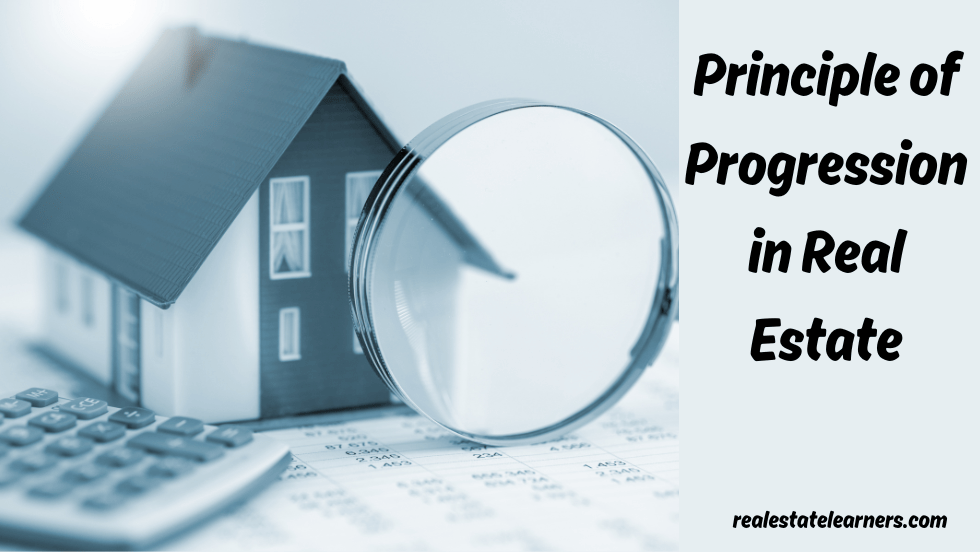In real estate, two important concepts that drive the market are progression and regression. Both of these principles play a crucial role in determining the value of a property.
This post will help you understand what progression and regression are, how they affect the real estate market, and why it is important to consider them when buying or selling a property.
What is the Principle of Progression in Real Estate?
The principle of progression states that a property’s value is affected by the quality and value of surrounding properties. This means that even if a property may not be very valuable, its worth can increase if more expensive and desirable properties surround it. On the other hand, if a property is located in an area with low-quality or less desirable properties, its value may decrease.
You may also know : What is the Principle of Substitution in Real Estate?
What is the Example of the Principle of Progression?
Example 1.
An example of the principle of progression in real estate can be seen in a residential neighborhood. Let’s say two identical houses are located next to each other, with the same square footage and amenities.
However, one house is in a high-end neighborhood with luxurious homes, while the other is in a run-down neighborhood with poorly maintained properties.
The house in the high-end neighborhood is likely to have a higher value due to its surroundings. Potential buyers would be more willing to pay a premium for the house as it is located in an attractive and desirable area compared to the one in the run-down neighborhood.
Example 2.
This same principle can be applied when considering commercial properties as well. For example, a retail store located in a popular shopping district will likely have higher value and potential for success compared to a similar store located in a less desirable area. The surrounding businesses, foot traffic, and overall appeal of the neighborhood can greatly impact the value and success of a commercial property.
In residential and commercial real estate, the principle of progression highlights the importance of location when determining the value of a property. It also emphasizes the role surrounding properties and amenities play in influencing a property’s worth.
What is the difference between the principle of progression and regression?
The principles of progression and regression explain how a property’s value can be affected by its surroundings.
However, there are key differences between these two principles:
The principle of progression states that a property’s value can increase if more valuable properties surround it. In contrast, the principle of regression suggests that a property’s value may decrease if less desirable properties surround it.
The principle of progression focuses on the positive impact of surrounding properties, while the principle of regression highlights the negative impact.
The principle of progression primarily applies to residential and commercial properties, while the principle of regression is often used to explain changes in agricultural land values.
The real estate progression principle is typically viewed as a more desirable concept for real estate investors, as it suggests the potential for increased value in a property, while the principle of regression may be seen as a risk factor.
The principle of progression is based on supply and demand, as desirable properties in a certain location are in high demand and can command higher prices. In contrast, the regression principle does not consider the market dynamics of supply and demand.
The principle of progression is often used as a selling point for properties in desirable locations. In contrast, the principle of regression may be viewed as a disadvantage for properties in less desirable areas.
Frequently Asked Questions
How can the principle of progression be applied in real estate investment?
The principle of progression can be used as a strategy for real estate investors to identify potentially valuable properties. By focusing on areas with desirable surroundings, investors may be able to purchase undervalued properties and see an increase in their value over time.
Is the principle of progression always true for determining property values?
While the principle of progression is a commonly accepted concept in real estate, it may only sometimes be true in some situations. Other factors, such as market trends, economic conditions, and specific property features, can also impact a property’s value.
Can the principle of progression be used in all types of real estate?
The principle of progression is primarily applied to residential and commercial properties. However, it may also be relevant for industrial or agricultural properties if their value is affected by surrounding properties or amenities. So, it can be used in most types of real estate investments.
How does gentrification relate to the principle of progression?
Gentrification is a process where a run-down, low-value neighborhood experiences an influx of residents and investments, increasing property values. This process aligns with the principle of progression as it demonstrates how surrounding properties and neighborhoods can greatly impact a property’s value.
Conclusion
The principle of progression is an important concept in real estate that emphasizes the impact of surrounding properties on a property’s value. By understanding this principle, investors can make informed decisions and potentially see an increase in their property’s worth over time.
Additionally, individuals looking to purchase a property can use this concept to identify valuable locations and properties with potential for future growth.

Corey has over 15 years of experience as a real estate broker and educator. He is dedicated to providing valuable insights and guidance for those looking to enter the real estate industry.

